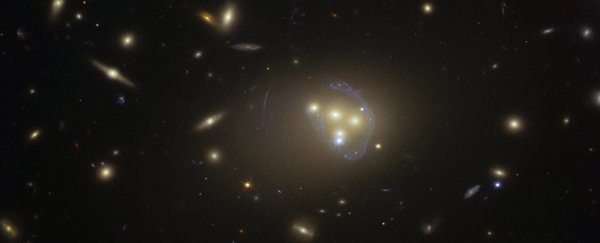Three years ago, a galaxy 1.3 billion light-years away gave astronomers a special clue on dark matter, indicating this mysterious stuff can interact with forces other than gravity. Now a new study has contradicted this finding, sending scientists back to the drawing board.
Dark matter is referred to as dark because the only sign of its presence is in the unusual movements of visible masses.
Unfortunately this doesn't leave us much to go on if we're to determine its identity, so it would be super useful if dark matter, which makes up nearly a third of the known Universe, did a little bit more than act like a giant poltergeist.
Several years ago, a team led by astronomers from Durham University thought they'd stumbled across a much needed break in dark matter research.
Data from the Very Large Telescope in Chile combined with Hubble images allowed them to trace the distribution of mass surrounding four colliding galaxies.
Using a process called gravitational lensing, they were able to 'see' pockets of dark matter and compare their positions with those of ordinary visible masses of stars.
For three of the galaxies, both types of matter lined up perfectly.
In the case of the fourth, located in the Abell 3827 cluster, it seemed as if its blob of dark matter wasn't inside the galaxy, but was instead offset slightly, trailing roughly 5,000 light-years in its wake as if it had snagged on something.
This shouldn't be confused with the more recent astonishing news of a galaxy found to be free of dark matter, which most likely formed that way.
This one was more like a galaxy caught with its dark matter pants down.
If verified, it would have suggested a force other than gravity could affect dark matter, a feature we could exploit to force it to give up more of its secrets.
That was a big if, and now it turns out that's not the case after all.
Following up on their find, the same team of researchers used the Atacama Large Millimetre Array (ALMA) in Chile to analyse the infra-red signature surrounding the area that contains the oddball galaxy.
This time they saw signs of dark matter that weren't obvious in their previous study, revealing the fourth galaxy was still well and truly married to its clump of dark matter.
"We got a higher resolution view of the distant galaxy using ALMA than from even the Hubble Space Telescope," says astrophysicist Liliya Williams from the University of Minnesota.
"The true position of the dark matter became clearer than in our previous observations."
This is a disappointing find in some ways, but the researchers remain pragmatic.
"The search for dark matter is frustrating, but that's science," says the study's lead author Richard Massey.
"Meanwhile the hunt goes on for dark matter to reveal its nature."
None of this should be taken to mean we can rule out dark matter interacting in some other interesting way with mundane varieties of physics and chemistry.
But it does mean we'll need to be a little more patient in our hunt for some way to make dark matter 'visible' to us - if it exists at all.
"We will keep looking for nature to have done the experiment we need, and for us to see it from the right angle," says Andrew Robertson from Durham University's Institute for Computational Cosmology.
The research is currently available for download on the pre-review website arxiv.org, and has been accepted for publishing in the Monthly Notices of the Royal Astronomical Society.
